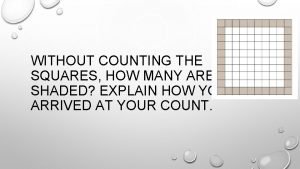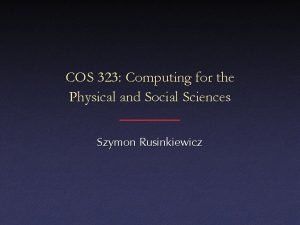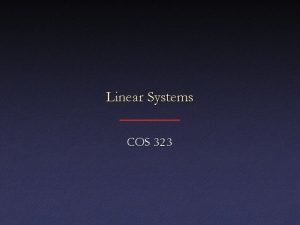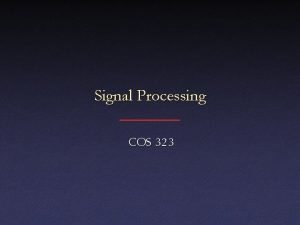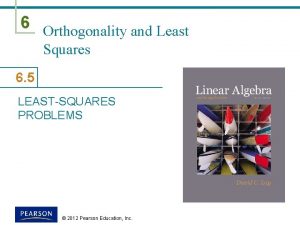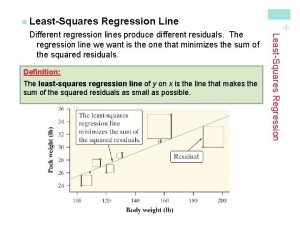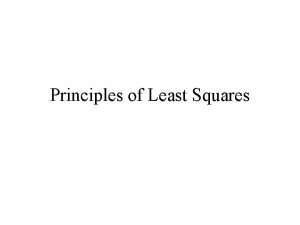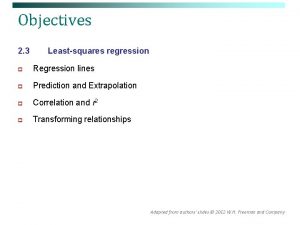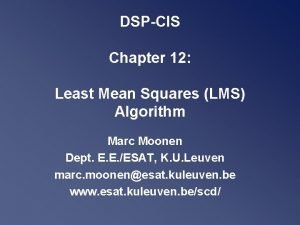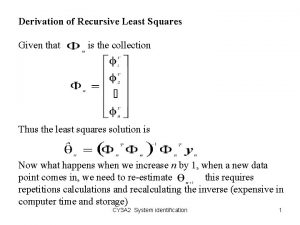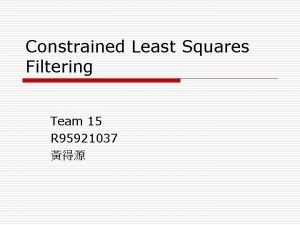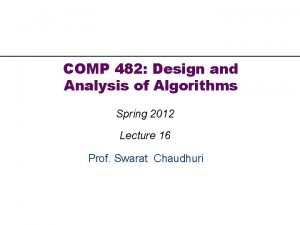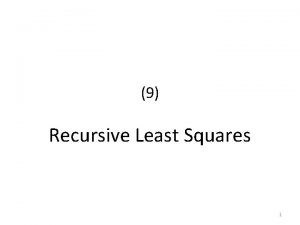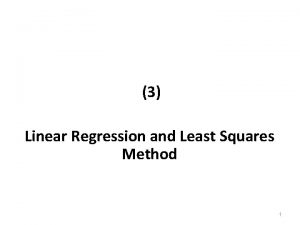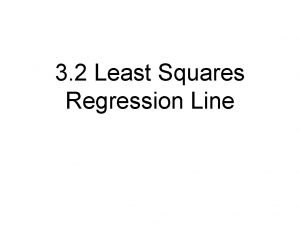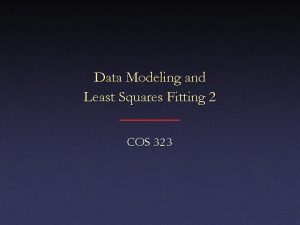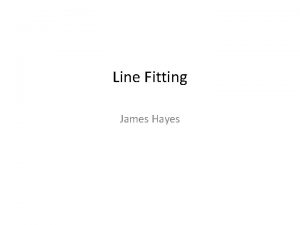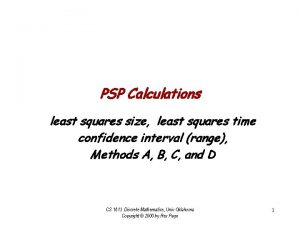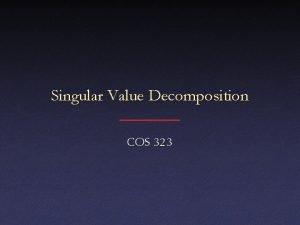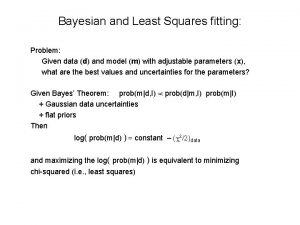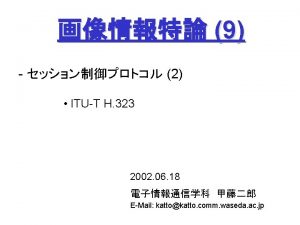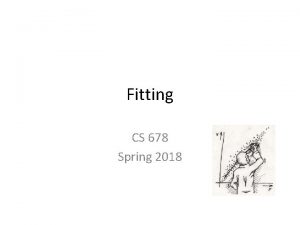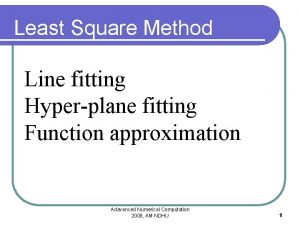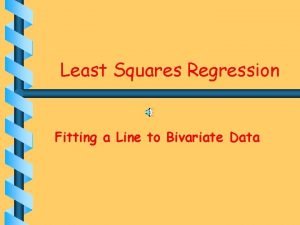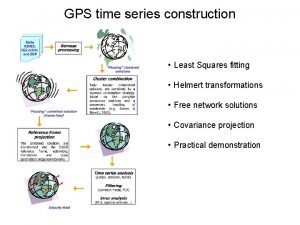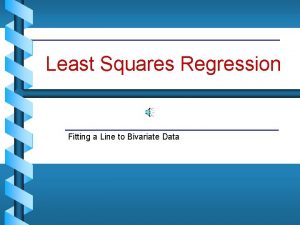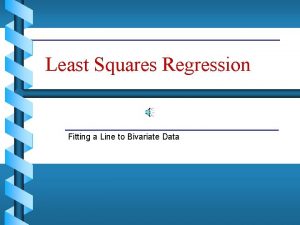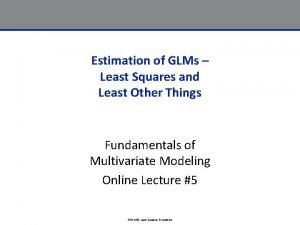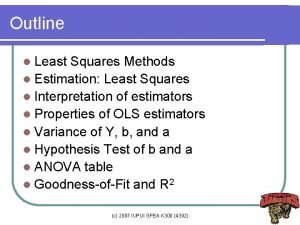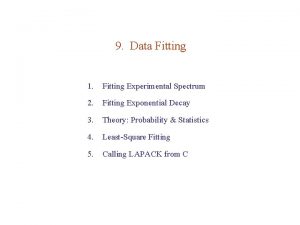Data Modeling and Least Squares Fitting COS 323

























- Slides: 25

Data Modeling and Least Squares Fitting COS 323

Data Modeling • Given: data points, functional form, find constants in function • Example: given (xi, yi), find line through them; i. e. , find a and b in y = ax+b (x 3, y 3) (x 5, y 5) (x 1, y 1) (x 6, y 6) y=ax+b (x 7, y 7) (x 2, y 2) (x 4, y 4)

Data Modeling • You might do this because you actually care about those numbers… – Example: measure position of falling object, fit parabola position time p = – 1/2 gt 2 Estimate g from fit

Data Modeling • … or because some aspect of behavior is unknown and you want to ignore it – Example: measuring relative resonant frequency of two ions, want to ignore magnetic field drift

Least Squares • Nearly universal formulation of fitting: minimize squares of differences between data and function – Example: for fitting a line, minimize with respect to a and b – Most general solution technique: take derivatives w. r. t. unknown variables, set equal to zero

Least Squares • Computational approaches: – General numerical algorithms for function minimization – Take partial derivatives; general numerical algorithms for root finding – Specialized numerical algorithms that take advantage of form of function – Important special case: linear least squares

Linear Least Squares • General pattern: • Note that dependence on unknowns is linear, not necessarily function!

Solving Linear Least Squares Problem • Take partial derivatives:

Solving Linear Least Squares Problem • For convenience, rewrite as matrix: • Factor:

Linear Least Squares • There’s a different derivation of this: overconstrained linear system • A has n rows and m<n columns: more equations than unknowns

Linear Least Squares • Interpretation: find x that comes “closest” to satisfying Ax=b – i. e. , minimize b–Ax – i. e. , minimize |b–Ax| – Equivalently, minimize |b–Ax|2 or (b–Ax)

Linear Least Squares • If fitting data to linear function: – Rows of A are functions of xi – Entries in b are yi – Minimizing sum of squared differences!

Linear Least Squares • Compare two expressions we’ve derived – equal!

Ways of Solving Linear Least Squares • Option 1: for each xi, yi compute f(xi), g(xi), etc. store in row i of A store yi in b compute (ATA)-1 ATb • (ATA)-1 AT is known as “pseudoinverse” of A

Ways of Solving Linear Least Squares • Option 2: for each xi, yi compute f(xi), g(xi), etc. store in row i of A store yi in b compute ATA, ATb solve ATAx=ATb • These are known as the “normal equations” of the least squares problem

Ways of Solving Linear Least Squares • These can be inefficient, since A typically much larger than ATA and ATb • Option 3: for each xi, yi compute f(xi), g(xi), etc. accumulate outer product in U accumulate product with yi in v solve Ux=v

Special Case: Constant • Let’s try to model a function of the form y=a • In this case, f(xi)=1 and we are solving • Punchline: mean is least-squares estimator for best constant fit

Special Case: Line • Fit to y=a+bx

Weighted Least Squares • Common case: the (xi, yi) have different uncertainties associated with them • Want to give more weight to measurements of which you are more certain • Weighted least squares minimization • If uncertainty is , best to take

Weighted Least Squares • Define weight matrix W as • Then solve weighted least squares via

Error Estimates from Linear Least Squares • For many applications, finding values is useless without estimate of their accuracy • Residual is b – Ax • Can compute 2 = (b – Ax) • How do we tell whether answer is good? – Lots of measurements – 2 is small – 2 increases quickly with perturbations to x

Error Estimates from Linear Least Squares • Let’s look at increase in 2: • So, the bigger ATA is, the faster error increases as we move away from current x

Error Estimates from Linear Least Squares • C=(ATA)– 1 is called covariance of the data • The “standard variance” in our estimate of x is • This is a matrix: – Diagonal entries give variance of estimates of components of x – Off-diagonal entries explain mutual dependence • n–m is (# of samples) minus (# of degrees of freedom in the fit): consult a statistician…

Special Case: Constant “standard deviation of samples” “standard deviation of mean”

Things to Keep in Mind • In general, uncertainty in estimated parameters goes down slowly: like 1/sqrt(# samples) • Formulas for special cases (like fitting a line) are messy: simpler to think of ATAx=ATb form • All of these minimize “vertical” squared distance – Square not always appropriate – Vertical distance not always appropriate
 How many squares
How many squares Cos 323°
Cos 323° Cos 323°
Cos 323° Cos 323°
Cos 323° Cos 323
Cos 323 Cos 323
Cos 323 Cos 323°
Cos 323° Cos 323
Cos 323 Cos 323
Cos 323 Cos 323
Cos 323 Cos 323
Cos 323 Least squares example
Least squares example Helen c. erickson nursing theory
Helen c. erickson nursing theory Damien thiesson
Damien thiesson Least squares regression line definition
Least squares regression line definition Observation equation in least square adjustment
Observation equation in least square adjustment Least squares regression line statcrunch
Least squares regression line statcrunch Lms cis
Lms cis Recursive least squares python
Recursive least squares python Constrained least squares filtering
Constrained least squares filtering 4d3d41669541f1bf19acde21e19e43d23ebbd23b
4d3d41669541f1bf19acde21e19e43d23ebbd23b Least squares example
Least squares example Least squares example
Least squares example Least squared regression line
Least squared regression line Nonlinear regression lecture notes
Nonlinear regression lecture notes Geometry of least squares
Geometry of least squares
